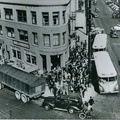Read Part 24 >>
On November 13, 1922, the United States Supreme Court ruled against Ozawa, declaring that as a “Mongolian” he was ineligible to citizenship. Justice Sutherland delivered the Supreme Court decision in the Takao Ozawa case:
On behalf of the appellant it is argued that we should give to this phrase [free white persons] the meaning which it had in minds of its original framers in 1790 and that it was employed by them for the sole purpose of excluding the black or African race and the Indians then inhabiting this country. It may be true that these two races were alone thought of as being excluded, but to say that they were the only ones within the intent of the statute would be to ignore the affirmative form of the legislation. The provision is not that Negroes and Indians shall be excluded but it is, in effect. that only free white persons shall be included. The intention was to confer the privilege of citizenship upon that class of persons whom the fathers knew as white, and to deny it to all who could nopt be so classified.1
The Japanese immigrant press reacted to the decision with anger and indignation, but little surprise. The leading advocate for the Ozawa case, the Shin Sekai, stated, “The slim hope that we had entertained. . .has been shattered completely.”2 To add greater hurt to the wound, Congress passed the Cable Act which directly affected Nisei women. The act stated that any American woman who married “an alien ineligible to citizenship shall cease to be a citizen of the United States.”3
THE NATIONAL ORIGINS ACT of 1924
The ultimate rejection by the United States came several years later when Congress passed the National Origins Act of 1924 which totally barred further Japanese immigration to the United States. The act also prohibited the entry of women from China, Japan, Korea, and India, while it permitted an unlimited number of European women to enter as wives. Even U.S. citizens could not bring wives from the designated Asian countries because they were classified as “aliens ineligible to citizenship.”
V.S. McClatchy, the publisher of the influential Sacramento Bee and the leader behind the Japanese Exclusion League of California, lobbied before Congress shortly before the passage of the Act: “The Japanese are the less assimilable and more dangerous as residents in this country than any other of the peoples ineligible under our laws,” he testified. “With great pride of race, they have no idea of assimilating. They have greater energy, greater determination, and greater ambition than other yellow and brown races ineligible to citizenship, and with the same low standards of living, hours of labor, use of women and child labor, they naturally make more dangerous competitors in an economic way.”4
After the passage of the National Origins Act of 1924, a deep sense of dejection and humiliation pervaded the Japanese immigrant communities. They had sought justice in the American judicial system only to discover that the Constitution did not apply to the Japanese immigrant.
Twenty-eight years later, with the passage of the Walter-McCarran Act of 1952, the Japanese were finally allowed the right to become naturalized citizens. The Act continued to restrict Asian immigration into the United States with Japan given a token quota of 185 immigrants per year.
With the certificate of naturalization
In my hand
I buy a tombstone next.5
Notes:
1. In Ernest K. Wakukawa, A History of the Japanese People in Hawaii, pp. 306-307.
2. Shin Sekai, November 14, 1922, in Yuji Ichioka, The Issei, p. 226.
3. See Yamato Ichihashi, Japanese in the United States, pp. 324-325.
4. U.S.Congress, Senate, Japanese Immigration Hearings, 68th Congress, 1st sess, (Washington, 1924), pp.5-6, 34, in Roger Daniels, The Politics of Prejudice, pp.99.
5. Airyu Mitsufuji, Hokubei Seiboku Senryu Jisen Kushu (Seattle 1957), translated by Sachiko Honda, “Issei Senryu,” In Gail Nomura et al, (Eds.), Frontiers of Asian Studies, p. 175.
* Issei Pioneers: Hawai‘i and the Mainland, 1885-1924 is the catalogue accompanying the National Museum’s inaugural exhibition. Using artifacts from the National Museum’s collection to tell the story of the courageous “Issei Pioneers,” the catalogue focuses on the early immigration and settlement years. To order the catalogue >>
© 1992 Japanese American National Museum






